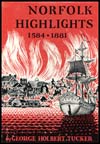Chapter 35
The Making of a Shrine
When the former Norfolk Court House and City Hall was renovated as a memorial to the General of the Army Douglas MacArthur and opened to the public in January of 1964, an earlier Norfolk tourist custom was reversed.
Four years after the completion of the building in 1850, visitors climbed the two flights of steps leading to its cupola, the highest point of vantage in the city, to get a bird's-eye view of the town and its harbor. Now tourists concentrate on the tomb of the general and the souvenirs of his military career displayed below in the area that once resounded with the gavels of justice.
The Classic Revival Court House was the architectural symbol of Norfolk's new dignity, acquired on February 13, 1845, when the Virginia General Assembly passed an act changing its status from a borough to that of a city.
The handsome building that housed Norfolk's courts for more than a century and was the scene of many stirring trials and other historic events was first occupied by "the Worshipful Court of the City of Norfolk" on May 20, 1850. Judge Richard Baker was the first to occupy the bench there.
In commenting on the opening of the building, the Daily Southern Argus took the judge to task for his dilatory manner of dispensing justice. "With all deference and respect," it said, "we hope Judge Baker will turn over a new leaf to insure a more prompt and efficient administration of the laws. As business is now conducted, it not only involves much delay and expense, but in many cases amounts to absolute denial of justice."
The Court House cost $50,000 to build and was erected on made ground, the site being part of what was formerly known as Town Back Creek.
On February 27, 1833, the Virginia General Assembly authorized the Borough of Norfolk to fill in that portion of the waterway extending east from the present Bank Street. At that time the Norfolk Borough Court House stood on East Main Street on the site later occupied by the Norfolk Union Mission. This court house was erected during 1790-91 and remained in use until the Court House facing on Bank Street was occupied.
By 1837, the site of the Court House, now the MacArthur Memorial, had been reclaimed from the waters of Town Back Creek, and by 1845 the city fathers were thinking in terms of the new building. On April 23, 1846, the issue was put to a vote, and Norfolk citizens approved the reclaimed land as a site for the building. Five months later, the Norfolk Common Council voted to go ahead with the building and paid William R. Singleton one hundred dollars for the plans he had prepared for it.
Singleton was one of the foremost American architects of his time. A native of Portsmouth, he was practicing in St. Louis, Missouri, at that time. His plans for the Norfolk County Court House in Portsmouth had made such a favorable impression that the Norfolk Council chose him.
Money for the new building was raised by selling the old Borough Court House on Main Street and by assessing each qualified Norfolk voter one dollar. Piles for the building were driven between May and July of 1847, and by the end of August the work had progressed sufficiently on the foundations for the cornerstone to be laid.
The parade that preceded the ceremony was pronounced by the newspapers to be the largest public procession in the history of the city. Lodge members in full regalia, military companies, naval officers, Norfolk area clergymen, and other prominent citizens rode in carriages or walked in the parade to the music of several bands.
The Masons conducted the cornerstone-laying ceremony, and the Reverend A.L. Hitzelberger, the pastor of Norfolk's St. Patrick's Catholic Church, "delivered an address which was characterized by elegance of style, combined with highly appropriate and classical allusions, and patriotic sentiments."
Chapter
36
The 1855 Yellow Fever Epidemic
Norfolk Highlights 1584 - 1881

See the "Table of Contents" for links to every chapter in Norfolk Highlights 1584 - 1881 by George Holbert Tucker.
